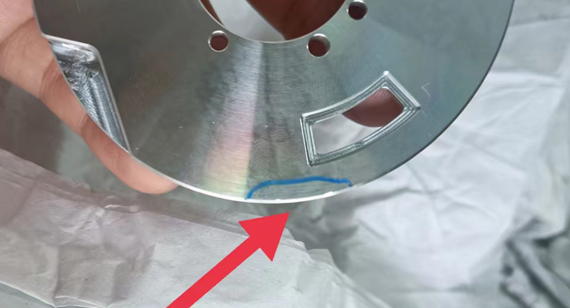15 years one-stop China custom CNC machining parts factory

Hey there I’m VMT Sam!
With 25 years of CNC machining experience we are committed to helping clients overcome 10000 complex part-processing challenges all to contribute to a better life through intelligent manufacturing. Contact us now
 535 |
Published by VMT at Apr 05 2024
535 |
Published by VMT at Apr 05 2024
In the process of manufacturing precision CNC machined parts, the application of CNC machining equipment is both widespread and critical. However, sometimes surface tool marks can occur during part machining, impacting not only aesthetics but also potentially the performance and accuracy of the parts. When faced with such issues, many initially question whether the tool selection was incorrect. However, in reality, the causes of tool marks in CNC machining can be diverse, with tool selection being just one factor. This article will delve into various aspects of the CNC machining tool mark issue to help readers better understand and address the problem.

I. Analysis of the Causes of CNC Machining Tool Marks
Improper Tool Selection and Usage
The selection of tools is crucial in CNC machining. Different materials and machining requirements necessitate matching different types of tools. If the tool material is unsuitable for the machining material, or if the geometric parameters of the tool (such as rake angle, clearance angle, etc.) are improperly set, tool marks may occur during machining. Additionally, tool wear and damage are common causes of tool marks. Therefore, when selecting tools, it's essential to consider factors such as the properties of the machining material, machining accuracy requirements, and cutting conditions.
Issues with Machine Tools and Fixtures
The accuracy and stability of machine tools directly affect machining quality. Vibrations, inadequate positioning accuracy, or insufficient rigidity in the machine tool can all lead to tool marks during machining. Similarly, the design and use of fixtures are critical factors affecting machining quality. Uneven clamping force or improper clamping methods may cause workpieces to move or deform during machining, resulting in tool marks.
Unreasonable Cutting Parameter Settings
Cutting parameters, including cutting speed, feed rate, and depth of cut, are crucial for ensuring machining quality. Setting cutting parameters too high or too low can lead to changes in cutting forces between the tool and workpiece, resulting in tool marks. Therefore, during CNC machining, cutting parameters should be reasonably adjusted based on factors such as machining material and machine tool performance.

II. Strategies for Resolving CNC Machining Tool Mark Issues
Optimizing Tool Selection and Usage
To address issues related to improper tool selection and usage, the following measures can be taken: Firstly, select suitable tool materials and geometric parameters based on the properties of the machining material and requirements. Secondly, regularly inspect tool wear and promptly replace heavily worn tools. Finally, adjust cutting angles and cutting speeds appropriately to minimize cutting forces and reduce the occurrence of tool marks.
Enhancing Machine Tool and Fixture Performance
To tackle machine tool and fixture issues, improvements can be made in the following areas: Firstly, enhance the accuracy and stability of machine tools to minimize vibrations and positioning errors. Secondly, optimize fixture designs to ensure uniform and stable clamping forces. Lastly, conduct regular maintenance and upkeep of machine tools and fixtures to ensure they are in good working condition.
Adjusting Cutting Parameter Settings
To address issues related to unreasonable cutting parameter settings, the optimal cutting parameter combination can be determined through experimentation and simulation analysis. Additionally, real-time monitoring of parameters such as cutting forces and temperatures during machining can guide adjustments to cutting parameters for optimal machining results.
III. Case Studies and Practical Insights
In actual production processes, many CNC machining factories have encountered tool mark issues. Through the analysis and summary of these cases, common problems and solutions can be identified. For example, a factory machining aluminum alloy parts noticed significant tool marks on the surface. Upon inspection and analysis, it was discovered that the tool marks were caused by severe tool wear. After replacing the worn tools, the tool mark problem was effectively resolved. Additionally, some factories have successfully addressed tool mark issues through optimization of cutting parameters and fixture designs.
IV. Conclusion and Outlook
The issue of tool marks in CNC machining is complex and significant, involving multiple factors such as tools, machine tools, fixtures, and cutting parameters. Therefore, resolving tool mark issues requires comprehensive consideration of various factors and the implementation of corresponding optimization and improvements. Furthermore, as CNC machining technology continues to advance, there may be more new methods and technologies available to address tool mark issues in the future. Therefore, experts and practitioners in the CNC machining field need to stay informed about and learn from new technologies and methods to continually improve machining quality and efficiency.
In summary, tool mark issues in CNC machining are not solely caused by incorrect tool purchases. In actual production processes, analysis and troubleshooting from multiple perspectives are necessary to identify the root causes of the problem and implement effective solutions. Only then can the quality and accuracy of CNC machined parts meet requirements, making a greater contribution to the development of the manufacturing industry.
Ready To Start Your Next Project?
Get Instant Quote

Request a Free Quote
Send us a message if you have any questions or request a quote. We will get back to you ASAP!